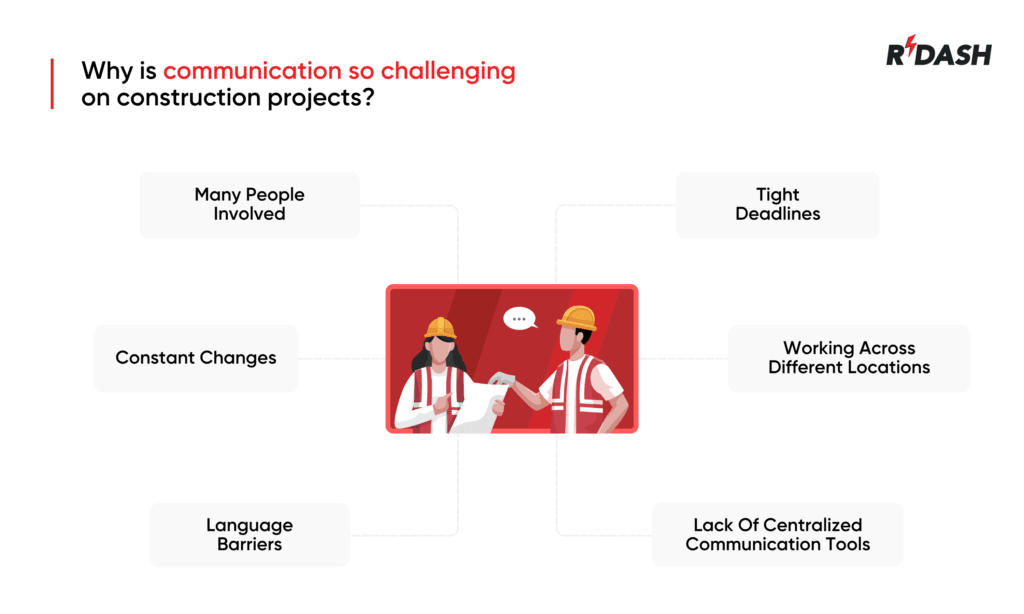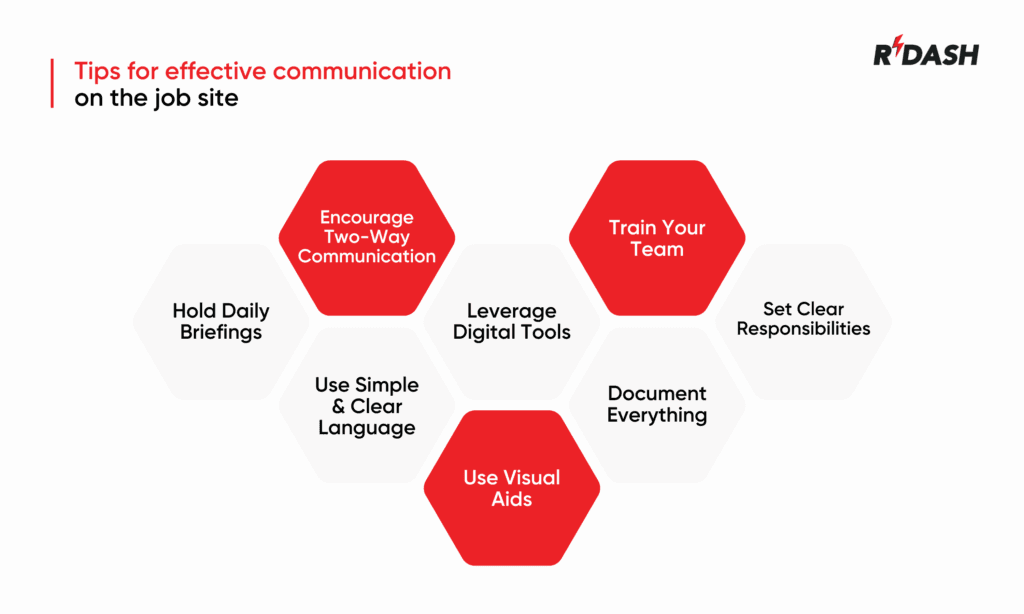What is effective communication on a construction site?
Communication plays a critical role in the success of any construction project. On a construction site, many people work together – project managers, contractors, subcontractors, designers, suppliers, and laborers. Effective communication means that everyone clearly understands their responsibilities, timelines, safety guidelines, and changes as the project moves forward.
Simply put, good communication on a construction site means delivering information quickly, clearly, and in a way that everyone involved can easily understand. This includes instructions, updates, feedback, and safety alerts. Good communication helps prevent confusion, delays, mistakes, and even accidents.
Why is communication so challenging on construction projects?
While communication sounds simple, it can be very difficult on a construction site. Let’s explore some common reasons why communication becomes a challenge:

1. Many People Involved
Construction projects have multiple teams and individuals who must work together — project owners, architects, engineers, contractors, subcontractors, and suppliers. Each group may have different priorities, work cultures, and ways of sharing information.
2. Constant Changes
Design changes, material delays, unexpected site conditions, and weather interruptions often require quick updates. If updates are not shared immediately, it can cause confusion and errors during the work.
3. Language Barriers
Construction teams often include people from different regions or countries who may not speak the same language fluently. This can cause misunderstandings if instructions or safety guidelines are not communicated clearly.
4. Lack Of Centralized Communication Tools
In many cases, teams still depend on phone calls, emails, or handwritten notes to share important information. Without a centralized digital platform, important updates may get lost or delayed.
5. Working Across Different Locations
Sometimes, key decision-makers like project owners or architects are not physically present on the site. Remote communication becomes difficult without proper tools, leading to delays in approvals and responses.
6. Tight Deadlines
Construction projects often run on tight timelines. Under pressure, teams may rush to complete work without properly discussing instructions or changes, leading to errors that could have been avoided.
Why is good communication essential on a construction site
On a construction site, poor communication can be costly. Misunderstandings often lead to mistakes, delays, and sometimes even dangerous situations. Strong communication sets a solid base for smooth project execution.
Here’s why it matters so much:
1. Reduces Costly Errors
When workers receive clear instructions, they understand exactly what tasks they need to complete.
This reduces the chances of doing the work incorrectly, which helps avoid costly rework.
2. Keeps The Project On Schedule
Timely updates allow teams to plan ahead and make adjustments as needed. Delays are often caused by people waiting for information or clarification. Clear communication keeps things moving.
3. Improves Safety
Clear communication ensures everyone understands safety protocols, potential risks, and emergency procedures. This also helps reduce the risk of accidents and injuries at the job site.
4. Increases Team Productivity
When everyone understands their responsibilities, timelines, and objectives, they can dedicate themselves to their tasks. Good communication helps teams coordinate better and stay productive.
5. Builds Stronger Relationships
Effective communication creates trust between team members, contractors, clients, and suppliers. When people feel heard and informed, it improves teamwork and reduces conflicts.
6. Supports Quick Decision-Making
Construction projects often need fast decisions when issues arise. Clear communication ensures that problems are reported and addressed quickly before they grow into bigger challenges.
Tips for effective communication on the job site
Here are some simple yet effective ways to improve communication on construction sites:

1. Hold Daily Briefings
Start each day with a short meeting to review the plan, assign tasks, and address any concerns. This ensures that everyone is informed before starting the work.
2. Use Simple And Clear Language
Avoid technical jargon that may confuse workers. Use clear, simple language to explain instructions so that everyone can understand.
3. Encourage Two-Way Communication
Allow workers to ask questions and give feedback. Communication must be two-way; both supervisors and team members should feel open to sharing information.
4. Use Visual Aids
Drawings, diagrams, and charts can help explain complex instructions. Visual aids are especially useful for teams with language differences.
5. Leverage Digital Tools
Utilize construction management tools or mobile apps to provide real-time updates, documents, and schedules. This helps keep everyone aligned, even when they’re off-site.
6. Document Everything
Keep records of important discussions, approvals, changes, and instructions. This creates a clear reference in case of disputes or confusion later.
7. Train Your Team
Offer communication training for managers and workers. Teaching basic communication skills can make a big difference on a busy construction site.
8. Set Clear Responsibilities
Clearly define who is responsible for what task. When roles are clearly defined, it minimizes confusion and prevents unnecessary duplication of tasks.
In simple words, clear communication on a construction site is not just helpful – it is critical for success.
How RDash can help
RDash is built specifically to solve the communication challenges faced in construction projects. Its features are designed to ensure that information flows smoothly between teams, no matter where they are.
1. Real-Time Updates
With RDash, all project updates are shared instantly with everyone involved. When schedules change, tasks are updated, or issues arise, the entire team receives notifications immediately. This helps avoid delays caused by waiting for information.
2. Centralized Document Management
All important documents – drawings, contracts, approvals, and change orders — are stored in one secure location. Team members can access the latest versions anytime, reducing the risk of using outdated or incorrect information.
3. Task And Responsibility Tracking
RDash clearly assigns tasks to specific team members, along with deadlines and progress tracking. This ensures that everyone knows their responsibilities and can easily see what needs to be done next.
4. Mobile Accessibility
Since many workers and supervisors are always on-site, RDash’s mobile-friendly platform allows them to access project data directly from their phones or tablets. This means decisions can be made quickly without needing to return to the office.
5. Better Collaboration With Stakeholders
RDash enables smooth communication between project managers, contractors, clients, and vendors. Everyone can view updates, share feedback, and approve changes from one platform, improving coordination across all levels.
6. Reduces Miscommunication
By having all project details in one place and eliminating multiple channels of communication like emails, calls, or handwritten notes, RDash helps avoid misunderstandings that often lead to mistakes and rework.
7. Transparency And Accountability
RDash keeps a complete log of all activities, approvals, and changes. This creates full transparency and makes it easier to track decisions, reducing disputes and increasing accountability among teams.






